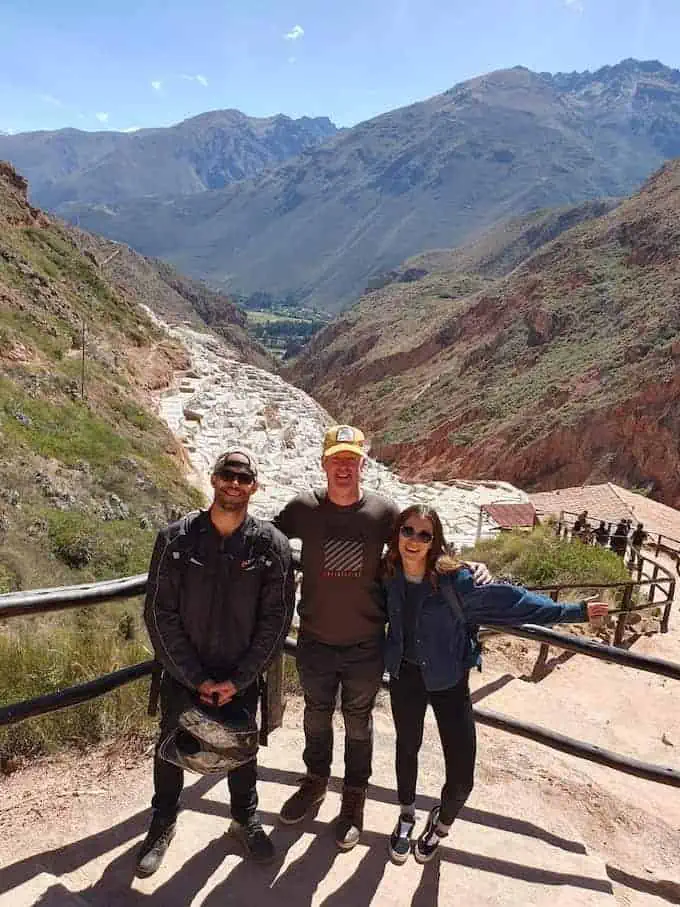I revved the throttle and the motorbike surged forward…
Adyashatmypants, Mr Desert and I were on our way to the Maras Salt Mines and the ancient ruins of Moray.
Adyashatmypants, you know already.
Mr Desert (aka Sean) is my other housemate. His nickname refers to the fact that he has a habit of wandering off mid-conversation (in other words, he “deserts” you 🤦♂️).
I’ve mentioned motorbikes before. My various adventures and close-calls with death. I still ride… but I’m a little more reserved than I used to be (thankfully).
Anyway, here we were, 3 people, 2 motorbikes, weaving and leaning our way through the Andean mountains of Peru…

…when something occurred to me while driving.
That my sense of safety was regulating my driving.
For example, if I started to feel unsafe (whether due to speed, rocks or dust on the road or those crazy buses that like to overtake on hairpin corners 😳), I’d find myself slowing down automatically…
…but if I felt completely safe and comfortable, I’d usually push forward, revving the bike and speeding up.
It made me think.
If my sense of safety was miscalibrated – that is, if I either couldn’t feel a sense of safety or if a little safety felt like a lot (or vice versa) – I’d either drive way too fast or way too slow.
This would cause a variety of problems:
If I drove too slow, it would take much longer than necessary to get to my destination (the salt mines or the ruins) and I’d end up with a bunch of angry drivers behind me who wanted to run me off the road…
…and if I drove too fast, I’d be the one getting pissed at the people in front of me, endangering them as well as myself (and my passenger).
It’s just like life, isn’t it?
If our “safety meter” is miscalibrated, we’ll either go too slow or too fast (creating problems and pain) 😫
In other words…
If our “safety meter” is miscalibrated and all wonky, we’ll overestimate the risk and danger in various situations (and we’ll slow down as a result) or we’ll underestimate the risk and danger (and we’ll speed up).
Just like with motorcycles, this means it’ll take longer for us to get to our destination (our various goals and dreams in life) or we’ll take unnecessary risks on our journey and increase the chances of bad things happening along the way (such as divorce, a health crisis or stubbing our toe on the bloody gutter).
Think about an anxious person. Never taking risks. Never putting themselves out there. Never standing up for themselves. Never going after what they want.
Maybe they dream of starting an online business so they can live and work anywhere but they never get around to it…
…or maybe they desperately want to fall in love but they never go on a date and never talk to people that they’re attracted to.
This person’s “safety meter” is under-calibrated, which means everything feels dangerous, and therefore, it’s near-impossible to move in the direction of what they want 😬
Now think about an overconfident, arrogant person who believes they can do no wrong.
You might think it’s better to be this way because then you’d simply do what you want to do.

You’d start the online business (and build it to millions of dollars in revenue within a few years). You’d find the hot partner and get married. And you’d have a blast riding motorcycles through the mountains.
But at what cost?
With an over-calibrated “safety meter”, everything feels safe and nothing feels dangerous.
As a result, you’d take more risks in business, increasing the chances of law suits, hostile takeovers and losing what you started…
…you’d invest less time and energy in your relationship, increasing the chances that it ends in a messy divorce…
…and you’d be far more likely to kill yourself (or someone else) in a motorcycle accident.
See what I mean?
Whether your “safety meter” is over- or under-calibrated, it’s dangerous.
You either end up severely limiting yourself, never making the most of your potential… or you destroy your life with all the stupid, unnecessary risks you take 😥
The question is…
How do you reprogram your safety meter?
How do you make sure that it’s sending a correct signal regarding what’s safe and what’s not?
Meditation doesn’t address safety (not in my experience).
Neither does breath work, journaling, gratitude lists, life coaching or even most therapists.
And I don’t think I’ve seen “safety” mentioned once in a self-help book.
That’s where the nervous system approach to healing comes in.
At the core of the nervous system approach is a focus on safety.
What is it?
What does it feel like?
And how can you recalibrate your sense of what’s safe and what’s not?
That’s why I talk about safety so much in these emails and in just about every rage inside The Rageheart Academy.
Because it is the foundation of everything else.
Everything else.
So –
if you’d like to recalibrate and repair your “safety meter”, keep reading these emails (to start) and join me inside The Rageheart Academy when you’re ready:

Cheers,
John Wood
P.S. Know anyone else who needs to recalibrate and repair their “safety meter”?
Refer them to The Daily Growl (this email newsletter) and help them reset their nervous system to a true sense of what’s safe and what’s not.

